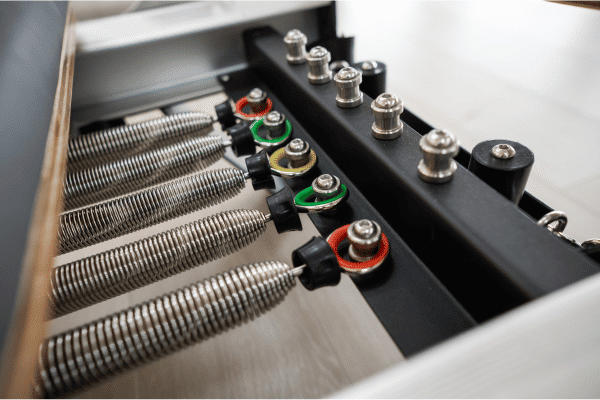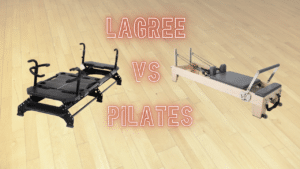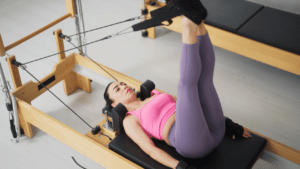
When Joseph Pilates first introduced the world to his fitness philosophy, the Reformer machine was right there with him, a core part of his vision. Today, while many might first imagine mats when they think of Pilates, the true aficionados know that the essence of Pilates lies in the innovative resistance of the Reformer. This isn’t just a return to form—it’s a deep dive into the original, powerful methods designed to enhance body strength, flexibility, and control. So, let’s step back in time and rediscover Reformer Pilates, the classic yet dynamic approach that’s making a profound resurgence in fitness circles.
What is Reformer Pilates?
Reformer Pilates revives the foundational exercise system created by Joseph Pilates, focusing on his core principles of control, fluidity, and precision. This method utilizes the Reformer, a sophisticated machine featuring a sliding carriage, adjustable springs, and various attachments.
The genius of the Reformer lies in its ability to provide resistance with the springs, which can be adjusted to a range of tensions to suit various skill levels and training goals. This allows for a range of exercises that can be performed to improve strength, flexibility, balance, and overall fitness. The movements done on this machine engage the whole body, though they particularly challenge the core, which Pilates practitioners often refer to as the “powerhouse.”
Read more about the Different Types of Pilates
How is Reformer Pilates Different from Other Pilates?
While the foundational principles of control, fluidity, and precision remain central to all forms of Pilates, Reformer Pilates stands out due to its use of specialized equipment. Unlike Mat Pilates, which relies solely on bodyweight for resistance, Reformer Pilates incorporates the use of its namesake machine to intensify the workout and provide a wider variety of movements.
The Reformer machine’s adjustable springs allow for customized resistance levels, making exercises more challenging as fitness improves. This adaptability makes Reformer Pilates particularly effective for a broad range of practitioners, from rehabilitation patients to elite athletes. The dynamic nature of the Reformer also promotes deeper muscle engagement and accelerates the development of core strength, flexibility, and balance.
Moreover, the structure of the Reformer supports the body in alignment and enables precise muscle targeting, something that is more challenging to achieve on a mat. This precision helps in effectively correcting posture and enhancing body awareness, key benefits that make Reformer Pilates a uniquely valuable practice.
How It Works – Understanding the Reformer Machine
To truly grasp the essence of the Reformer machine, we must revisit its historical roots crafted by Joseph Pilates during WWI. Originally, Pilates developed his equipment using what was at hand—hospital bed frames and straps. As a nurse in an internment camp, he ingeniously utilized these materials to aid bedridden inmates. By attaching springs to the bed frames, he enabled these patients to start exercising their atrophied limbs, effectively melding his knowledge of yoga, Zen meditation, and focused breathing into a rehabilitation exercise.
This innovative approach not only helped to strengthen and stretch the bodies of those confined to their beds but also laid the groundwork for what would become the modern Reformer machine. Today’s Reformer builds on these principles of resistance-based training, providing adjustable resistance via springs, which supports a diverse range of exercises. The carriage moves smoothly along the frame, and the adjustable springs are tailored to different levels of exercise difficulty, aligning with Pilates’ core principles of control, fluidity, and precision.
Equipped with a footbar, straps, and a sliding carriage, the modern Reformer allows practitioners to perform exercises lying down, sitting, or standing. This versatility supports full-body engagement and fosters improvement in balance, flexibility, and core strength, underpinning the rehabilitative and strengthening intents of its original design.
Benefits of Reformer Pilates
By marrying resistance with a range of movements, the Reformer offers a holistic exercise that significantly amps up the health quotient. Here’s why legions of fitness enthusiasts are turning to Reformer Pilates to spice up their routine:
Strengthen the Core
At the heart of Reformer exercises is core strengthening. The ‘powerhouse’—as Pilates aficionados call it—is engaged in almost every move, ensuring an abdominal workout that’s both intense and effective.
Enhance Flexibility and Range of Motion
The controlled, stretching movements of Reformer Pilates not only enhance flexibility but also expand your range of motion. Over time, this leads to better posture and less muscle stiffness.
Full Body Workout
Reformer Pilates is an all-encompassing gym session rolled into one machine. Whether it’s toning legs, firming up arms, or sculpting the back, this machine has a move for every muscle.
Improved Posture and Alignment
The precision of Reformer Pilates trains your body to maintain proper alignment, promoting better posture and reducing the risk of injury in everyday activities.
Low Impact Yet Highly Effective
Ideal for those with joint issues or injuries, Reformer Pilates provides a low-impact workout that’s kind on the body but tough on calories and muscle inefficiencies.
Mind and Body Connection
Just like its early days in the internment camp, Reformer Pilates emphasizes the importance of mindful exercise. The focus on breathing and smooth movements enhances mental clarity and reduces stress.
Customizable Workouts
With settings to adjust resistance and a variety of exercises, Reformer Pilates can be tailored to challenge anyone, from beginners to seasoned athletes.
Speeds Up Recovery
Its origins in rehabilitation are still evident as Reformer Pilates continues to be a go-to method for those looking to recover from injuries and improve their overall physical therapy regimen.
Types of Pilates Reformer: Classic vs Contemporary
Reformers come in many styles, but they generally fall into two main groups: classical and contemporary. Classical reformers are all about sticking to tradition. They’re usually made of wood and rely on spring resistance systems. These are the go-to for purists who want to stay true to Joseph Pilates’ original method. They emphasize nailing down precise form and technique, often resulting in a challenging workout due to the increased resistance from non-bearing wheels on the carriage.
By contrast, contemporary reformers are all about embracing the modern age. They often sport metal constructions and typically offer a mix of spring tensions—color-coded for ease of use—and incorporate smooth, precision bearings for easier movement of the carriage.

These reformers are known for their adaptability, offering a wider range of exercises and adjustments to suit different fitness levels and preferences. Ultimately, the choice between classical and contemporary reformers hinges on individual preferences, with classical models appealing to those seeking authenticity and tradition, while contemporary options attract those desiring versatility and innovation in their Pilates practice.
What to Look for When Buying a Pilates Reformer
Choosing the right Pilates Reformer is crucial for enhancing your practice and achieving your fitness goals. Here’s what you should consider when shopping for one:
Type
As mentioned above, you can choose between Classical and Contemporary Reformers. For beginners, we recommend a high-quality Contemporary Reformer that prioritizes safety and comes equipped with multiple accessories to facilitate progress and diversify your practice.
Dimensions
Reformers are sizable pieces of equipment. Measure your available space to ensure the Reformer fits comfortably. For smaller spaces, consider a foldable Reformer that is more portable and can be stored upright when not in use, saving valuable room.
Weight Capacity
Check the maximum training load of the Reformer, especially if you plan to incorporate additional weights into your workouts. Ensuring the Reformer can support your weight and any added equipment is essential for safety.
Adjustability
Adjustability is key for a tailored workout experience. Look for a Reformer with an adjustable spring bar, foot bar, and headrest. This feature is particularly important if multiple people will use the equipment, as it allows for personalized settings that accommodate different body types and flexibility levels.
Resistance System
The quality and type of resistance system in a Pilates Reformer are vital for tailoring workouts to meet diverse needs. Most high-quality Reformers utilize springs rather than cords due to their durability and consistent resistance. Here’s what to consider when evaluating this system:
- Type of Springs: Classical Reformers typically come with four springs of equal tension, providing a uniform resistance that’s integral to traditional Pilates methods. In contrast, Contemporary Reformers often feature three or four color-coded springs of varying weights. This variety allows for more customizable resistance settings to suit different strength levels and exercises.
- Number of Springs: A Reformer should ideally have multiple springs to offer various resistance levels. This is particularly important for those who plan to use their machine in a professional setting or with multiple users, allowing for adjustments to accommodate everyone from beginners to advanced practitioners.
- Spring Tension and Carriage Dynamics: In addition to the number and type of springs, consider how the carriage is supported. Classical Reformers often lack precision bearings on the wheels that support the carriage on its rails. This design choice increases resistance when returning the carriage to its starting position, making exercises more challenging and demanding. Contemporary Reformers typically feature precision bearings that allow smoother and easier carriage movement.
Special Features
Some Reformers come equipped with innovative accessories that enhance workout intensity and diversity. For instance, adding a jump board, which is a padded board placed in front of the regular footboard, introduces cardiovascular elements to your Pilates routine, making exercises more challenging.
How to Do Reformer Pilates Without a Reformer
Missing the Reformer but still want to capture the essence of its workouts? Here are some clever ways to replicate Reformer Pilates exercises at home using accessible tools:
Resistance Bands: Mimic the tension and resistance of Reformer springs with resistance bands. These versatile tools can help perform a variety of Pilates movements, from arm stretches to leg lifts, offering adjustable intensity to suit your strength level.
Foam Rollers: While primarily used for muscle relaxation and recovery, foam rollers can also challenge your balance and stability, much like the moving carriage of a Reformer. Use them for abdominal exercises, pelvic lifts, and other core-focused movements to enhance muscular control and proprioception.
Sliders or Towels: If you’re aiming to recreate the smooth gliding motion of the Reformer’s carriage, sliders are your go-to. If you don’t have sliders, paper plates, coffee filters or small towels can work just as effectively. Place them under hands or feet on a smooth surface, and they require you to engage your core to control movements during exercises like lunges and planks, closely simulating the Reformer’s demands.
TRX: Suspension training uses your body weight and gravity as resistance, offering a range of exercises that enhance flexibility, balance, and core strength. TRX Pilates is particularly effective for those looking to add a dynamic and challenging element to their workouts.
Swedish Ladder: The Swedish Ladder is a versatile piece of equipment, featuring multiple rungs that offer different angles and levels of resistance using your body weight. It allows for a wide variety of exercises that can strengthen, stretch, and enhance body control. Its adaptability makes it a great alternative for those looking to replicate some of the Reformer’s benefits without needing specialized equipment.
Pilates Springboards: Pilates Springboards are becoming a popular alternative to Reformers due to their affordability and space efficiency. These boards are equipped with springs that provide resistance similar to that of a Reformer. The main difference is that the Springboard does not have a carriage to support the body, which requires users to engage more control and body strength to maintain balance and execute movements. This setup is akin to working with a TRX system, where bodyweight and resistance demand a high degree of muscular integration and control.
Megaformer: Built with some of the same principles as a Pilates Reformer, the Megaformer is designed more for strength building and cardio. Central to Lagree Fitness, it offers high-intensity, low-impact workouts that push endurance and strength to new levels. For a more compact and affordable option, consider the Microformer. Learn more about the difference between Lagree and Reformer Pilates and how to use the Megaformer for Pilates.
Anything with Wheels: For an inventive approach, consider using any item with wheels, such as an office chair or skateboard. These can replicate the Reformer’s sliding carriage, offering a unique way to challenge your balance and core strength during exercises. Ensure safety by checking the stability of the item and use it on a suitable surface to prevent slipping.
Final Thoughts on Reformer Pilates
Reformer Pilates bridges the old and the new, blending Joseph Pilates’ time-honored principles with today’s biomechanical advancements. This exercise form is about precision, control, and a smooth flow, qualities embodied by both classical and contemporary Reformers.
Whether you choose to engage with a Classical or Contemporary Reformer, or even alternative equipment like resistance bands, TRX systems, or Pilates Springboards, the core principles of Pilates can still be effectively applied. Each piece of equipment, regardless of its complexity or simplicity, serves as a tool to deepen body awareness and enhance physical health through the mindful, deliberate movements characteristic of Pilates.
Ultimately, Reformer Pilates is about more than just equipment; it’s about a holistic approach to wellness that continues to adapt and evolve, ensuring its relevance and effectiveness for years to come.
Related Articles



